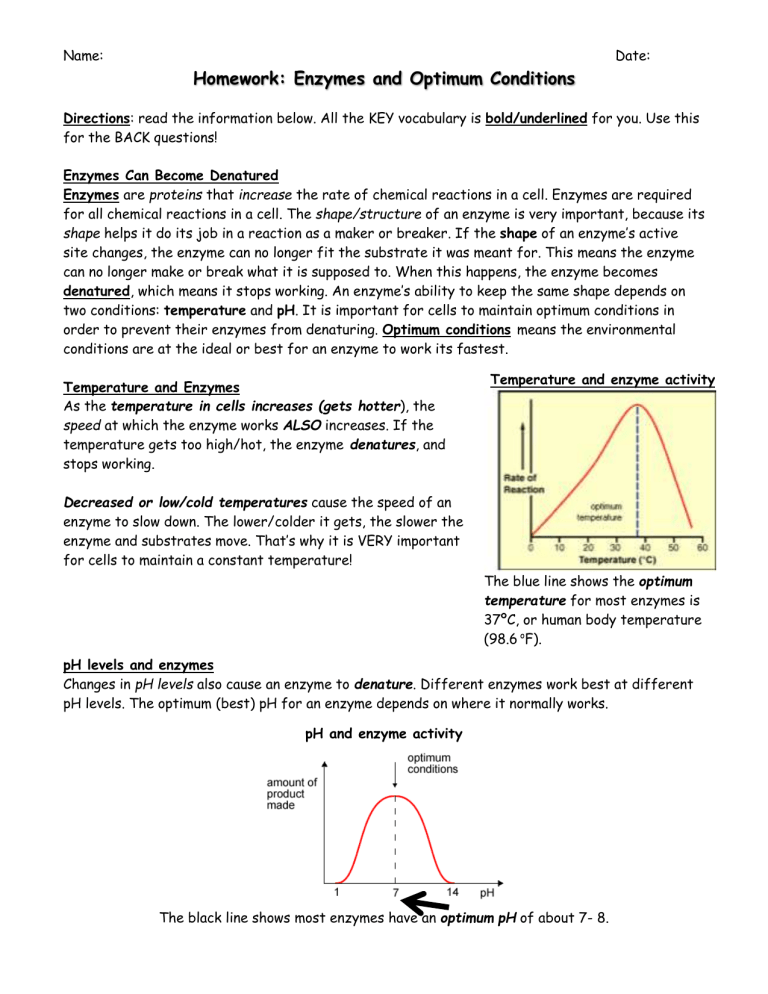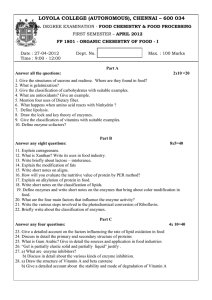Enzymes and Optimum Conditions Homework
advertisement

Name: Date: Homework: Enzymes and Optimum Conditions Directions: read the information below. All the KEY vocabulary is bold/underlined for you. Use this for the BACK questions! Enzymes Can Become Denatured Enzymes are proteins that increase the rate of chemical reactions in a cell. Enzymes are required for all chemical reactions in a cell. The shape/structure of an enzyme is very important, because its shape helps it do its job in a reaction as a maker or breaker. If the shape of an enzyme’s active site changes, the enzyme can no longer fit the substrate it was meant for. This means the enzyme can no longer make or break what it is supposed to. When this happens, the enzyme becomes denatured, which means it stops working. An enzyme’s ability to keep the same shape depends on two conditions: temperature and pH. It is important for cells to maintain optimum conditions in order to prevent their enzymes from denaturing. Optimum conditions means the environmental conditions are at the ideal or best for an enzyme to work its fastest. Temperature and Enzymes As the temperature in cells increases (gets hotter), the speed at which the enzyme works ALSO increases. If the temperature gets too high/hot, the enzyme denatures, and stops working. Temperature and enzyme activity Decreased or low/cold temperatures cause the speed of an enzyme to slow down. The lower/colder it gets, the slower the enzyme and substrates move. That’s why it is VERY important for cells to maintain a constant temperature! The blue line shows the optimum temperature for most enzymes is 37ºC, or human body temperature (98.6 oF). pH levels and enzymes Changes in pH levels also cause an enzyme to denature. Different enzymes work best at different pH levels. The optimum (best) pH for an enzyme depends on where it normally works. pH and enzyme activity The black line shows most enzymes have an optimum pH of about 7- 8. Name: Directions: Use the reading to complete ALL of the questions. Date: Vocabulary Directions: Use the reading to fill-in the definitions for each term below. enzyme: ___________________________________________________________________ __________________________________________________________________________ denatured: _________________________________________________________________ __________________________________________________________________________ Optimum conditions: __________________________________________________________ __________________________________________________________________________ Directions: Use the information from the reading to answer the questions below. Make sure to read the graphs & the captions! 1. What type of macromolecule are enzymes? ________________________ 2. Identify one reason why enzymes are important for cells. __________________________ _______________________________________________________________________ _______________________________________________________________________ 3. Why is the shape of an enzyme important? _______________________________________ _____________________________________________________________________ 4. Explain why an enzyme stops working once it is denatured. 5. Identify two conditions that cause an enzyme to denature. 6. Explain why enzymes don’t work very fast at low temperatures: 7. What is the OPTIMUM TEMPERATURE for enzymes? ____________________ 8. What is the optimum pH for enzymes? ____________________



